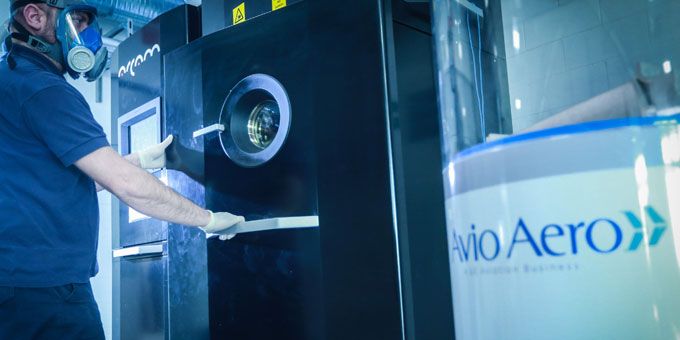The 11-foot diameter engine contains six different 3D-printed parts, which includes the low-pressure turbine blades made from an alloy of titanium and aluminum at the Avio Aero Cameri plant in Italy.
 How Materialise Software Solutions Helped to Create the World’s Largest Jet Engine
How Materialise Software Solutions Helped to Create the World’s Largest Jet Engine

Contributed by | Materialise
The GE9X, the largest jet engine in the world developed for Boeing’s next-generation 777X jets, took its maiden flight on the GE flying testbed in March 2018. Its crucial 3D-printed turbine parts were created using Materialise software solutions.
In this new era of additive manufacturing (AM), GE Aviation spearheads using 3D printing to advance the aviation industry. Case in point: the famous 3D-printed fuel nozzle, a benchmark of design optimization. This success story exemplifies how 3D printing can add value in specific manufacturing applications. Today we take a step further: AM is now ready to tackle industrial mass production and once again Avio Aero (a GE Aviation business) is setting the pace with the GE9X, the world’s largest jet engine.
Meeting the challenges of certified 3D printing at an industrial scale
The 11-foot diameter engine contains six different 3D-printed parts, which includes the low-pressure turbine blades made from an alloy of titanium and aluminum at the Avio Aero Cameri plant in Italy. The 3D-printed blades spin inside the engine at 2,500 times per minute weathering extreme conditions including heat and forces. Beyond meeting all technical requirements, the production process of the 3D-printed blades is both cleaner and cheaper than the more traditional molding technology used to produce these parts.

By peak production period – between 2022 and 2023 – Avio Aero estimates that 60 thousand blades will be produced per year for just these 3D-printed TiAl blades alone. The challenge is therefore to scale up 3D-printed part production to an industrial level, while meeting the high standards of the aerospace industry and maintaining industrial efficiency in the production environment.
With this objective in mind, Avio Aero plans to add 10 more Arcam (GE Additive) Electron Beam Melting (EBM) machines by the end of the year to the 40 existing Arcam systems that are in operation in their factory today.
Robust and integrated software solutions to power Industry 4.0
Certified 3D printing at an industrial scale requires maximum traceability, quality control, and repeatability while ensuring a high throughput with efficiency in machine operation time, waste minimization, and cost control.
From design to production and finishing, every step of the process must be optimized and integrated to enable this seamless and efficient digital production set up. To meet this challenge head-on, Avio Aero relies on a robust and integrated AM software solution that allows them to scale their 3D printing business efficiently, reliably, productively, and securely.
Connectivity, traceability, productivity — how software can help
Ever since the Cameri production facility opened its doors in 2013, the Materialise Streamics AM management system has been the key ingredient that enables Avio Aero’s AM process control and automation.
Avio Aero selected Streamics because it fulfills the AM process control, process standardization, process automation, and process traceability requirements of the highly demanding aeronautics additive manufacturing standards at Avio Aero in a unique way. Streamics is designed to increase connectivity, and for Avio Aero this means having the possibility to integrate their AM business with their ERP system (SAP).
All manufacturing operations, from platform preparation to finishing, run through Streamics. The process begins with part file preparations in Materialise Magics and offers all necessary tools for part fixing, positioning, support generation, labeling, and many more data and build preparation operations. It will then automate platform preparations while storing, tracking, and visualizing all AM process data and centrally managing and monitoring the machines and build jobs through Streamics.
If you like this article you may like "Quick Guide to Metal Additive Manufacturing for Industrial Components"
“For us, the most important benefit of using Materialise software is the ability to directly connect our 3D printing machines to our SAP production planning tool. This connection provides us with data from the factory floor on the status of each print, on how long production is going to take, and when the print is ready to go to the next station.” – Danila Marco, Digital Technology Additive Leader.
“To take advantage of large-scale 3D printing in an increasingly cost-competitive environment, manufacturing companies require increased productivity and efficiency and a seamless integration of 3D printing into their existing and proven production processes, Materialise Streamics will help Avio Aero to do just that” says Stefaan Motte, VP & Managing Director of Materialise Software,
Additionally, Avio Aero benefits from Materialise’s partnership with Arcam to run their 40 Arcam Electron Beam Melting (EBM) machines. The integrated Arcam Build Processor ensures more seamless communication to and from the machine and allows Avio Aero to set up the most optimal parameters for the build of the blades, as well as capture feedback and trace and store specific build job data back in Streamics for optimal traceability and control.
“The Arcam Build Processor is integrated with both the Materialise software solutions we use, Magics and Streamics. This integration streamlines our whole production environment. Besides simplicity, the build processor enables Streamics to store the data from all print jobs, which eventually gives us better control over our production. This is crucial in the aerospace industry.” - Danila Marco, Digital Technology Additive Leader.
Soaring to new heights in AM, together
In the era of Industry 4.0 close collaboration, trusted partnerships and integrated AM software solutions give wing to more control, more efficiency, more choices, more productivity. In this instance, the interplay of industry leaders Avio Aero (a GE Aviation business), Arcam (GE Additive), Boeing, and Materialise has culminated in turbine blades that allow the world’s biggest jet to soar.
The content & opinions in this article are the author’s and do not necessarily represent the views of ManufacturingTomorrow
Comments (0)
This post does not have any comments. Be the first to leave a comment below.
Featured Product

